June 2, 2014
by Carole Zangari -
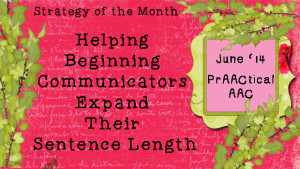
Nothing makes an AAC SLP happier than seeing beginning communicators start to use symbols to express themselves. Sure, it is great when a learner grabs your arm to lead you to the snack cupboard or hands you a juice box to get help opening it. Those are important communicative acts that we celebrate. But moving beyond pre-symbolic forms of communication to using signs and pictures, allows us to expand their vocabularies outside of the ‘here and now’ and enables them to communicate effectively with less familiar partners. When we’ve crossed the bridge into symbolic communication, we’re building a foundation for language development. If things go well, the learner will steadily acquire new symbols and words, eventually allowing us to work on word combinations. Are you working with AAC learners who at the early sentence level? If so, you may be considering how to build the length and complexity of their... [Read More...]
Filed under: Strategy of the Month
May 26, 2014
by Robin Parker -
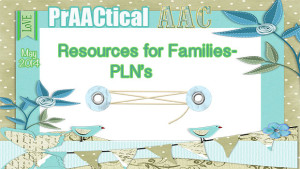
This month’s ‘Strategy of the Month’ has been focused on supporting families. To fully support families, it is essential to provide family friendly resources that can aid in creating Personal Learning Networks (PLN’s). The more families know and learn, the more likely the AAC learner will progress in their communication skills. Also, the more information families have, the better advocates they will become. And since families are one of the only constants in an AAC learner’s educational and life journey, the family is really the most important part the communication team. About AAC About AAC- ASHA AAC Institute- Parent’s Corner Center for AAC & Autism AAC -Family Resources Assistive Technology Resources- Autism Speaks Communication Matters Communication Books & Boards ConnectAbility http://www.setbc.org/pictureset/ Pre-made Communication Boards Help Designing Communication Books Free & Discounted AAC Apps Appy Malls Smart Apps for Kids Moms with Apps The iMums Apps Wheel *(categorized wheel of apps to... [Read More...]
Filed under: Strategy of the Month
Tagged With: Apps, communication boards, COmmunication Books, Family support, resources
May 19, 2014
by Carole Zangari -
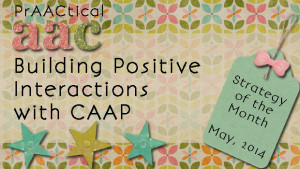
One of the challenges in helping AAC learners maximize their communicative potential is that they often interact with people who do not facilitate positive interactions. We know, for example, that partners may focus on the SGD rather than the topic or communicator (e.g., “Can you find ‘go?’, “Press it again”). They may dominate the conversation by taking more than their fair share of turns, making for a lop-sided and uninteresting context that is more of a monologue than a true conversation. They also tend to interrupt the AAC learner, often in an attempt to guess the learner’s message, save time, or correct the person. These actions come from a good place (wanting to support the learner) but are not things that facilitate improved communication. In a previous post, we talked about the RAAP strategy, for building partner skills during storybook reading. In this post, we continue to share the work of... [Read More...]
Filed under: Strategy of the Month
Tagged With: CAAP, Cathy Binger, Jennifer Kent-Walsh, strategy
May 12, 2014
by Robin Parker -
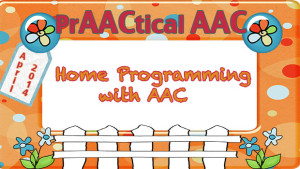
As SLP’s we love to have families learn and carryover the work we do in speech-language treatment sessions. This helps ensure carryover of progress and generalization of therapy success. However, as Carole clearly illustrated last Monday, there are a lot of family dynamics, cultural issues, and family challenges that make adding extra work possibly burdensome. We really (really) do not want to burden families, but its beneficial to have AAC communication happen all day long. We once had a client who had a very huge house with lots of bedrooms, but mom chose to keep her children together in one bedroom. This was just in case the AAC user woke in the middle of the night. Then she would have someone close by as a communication partner. This was a family who took home programming to the max and expanded and modified it to fit their family. A main issue... [Read More...]
Filed under: Strategy of the Month
Tagged With: Family support, home programs
May 5, 2014
by Carole Zangari -
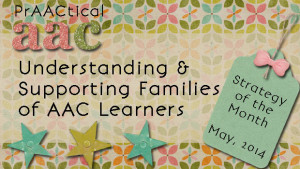
Let’s start with a basic premise: We can’t maximize AAC learning outcomes unless we’re working well with families. This is easier said than done, especially in some settings. As a clinician in a university clinic, for example, seeing families is the norm. We get to interact with them before and after the therapy. They get to observe or participate in the session. We can show them the data, observe how they interact with the AAC user in their family, and answer questions as they arise. And even with all of that, supporting them is challenging in that it takes time, skill, and planning. Although it is one of our favorite things to do, it’s not always easy to align our actions with our (stellar, ambitious) intentions. Multiply that by a factor of a zillion for our colleagues in schools and other settings where frequent, casual interactions are difficult to come... [Read More...]
Filed under: Strategy of the Month
April 28, 2014
by Robin Parker -
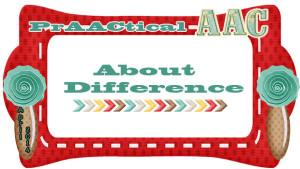
Filed under: Strategy of the Month
Tagged With: Quote
April 21, 2014
by Robin Parker -
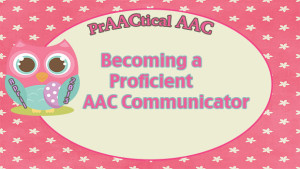
Filed under: Strategy of the Month
Tagged With: AAC Quote, communication
March 31, 2014
by Carole Zangari -
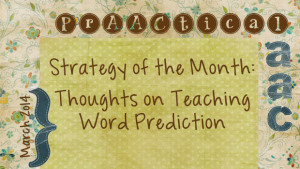
As we wrap up a month of AAC and literacy, let’s look at a strategy that spans communication, reading, and writing. Word prediction, as you know, is a strategy in which the learner begins spelling a word and the AAC device provides a word bank of possible options using a prediction algorithm. There are lots of kinds and levels of prediction, and the technology keeps getting better and better. Word prediction is built into most high tech SGDs, many text-to-speech apps, and some writing programs. In this post we consider some of the issues around using and teaching word prediction. Time and Effort Word prediction (WP) saves keystrokes, which is important for our prAACtical friends who have limited energy, poor endurance, and issues with fatigue. Does it save time? Not always, and there were some important studies that revealed this in the mid-1990’s. Of course, technology has improved a lot... [Read More...]
Filed under: Strategy of the Month
Tagged With: literacy, word prediction
March 24, 2014
by Robin Parker -
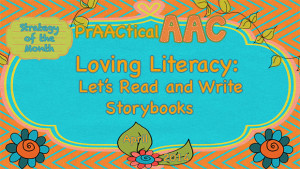
Literacy instruction involves lots of reading and writing. Last week, Carole discussed using storybook reading and the RAAP (Read, Ask, Answer, Prompt) strategy by Drs. Cathy Binger and Jennifer Kent-Walsh to teach communication and literacy. To use storybooks with all learners we need to have lots of books that are easily accessible. Books need to be accessible physically as well as through content and interest. It is lucky that with all of today’s on-line resources there is an abundance of ways to obtain as well as make and write storybooks. All learners can and should be be involved in both the reading and writing process. Not only do literacy skills improve but so do communication skills. Involving Learners in the Storybook Process Reader & Writer Vocabulary- Facilitate involvement by using reader and writer vocabulary. Refer to learners as “readers”, “authors”, “editors”, “publishers”, “critics”, etc. When you are treated and referred... [Read More...]
Filed under: Strategy of the Month
Tagged With: adapted books, literacy, resources, writing
March 10, 2014
by Robin Parker -
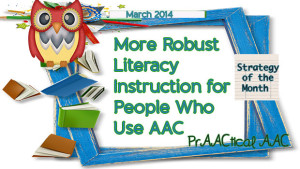
We love learning about AAC and literacy from resources that have a ‘presume competence’ philosophy, that provide research support, and that include specific teaching guidelines. With these ideas in mind, we love the Literacy Curriculum found on the Literacy Instruction Website by Janice Light and David McNaughton at Penn State. There are specific guidelines for providing literacy instruction to individuals with severe communication impairments. There is a specific curriculum to tell you what skills to teach, reasons for teaching those skills, how to teach the skills, and videotaped examples of teaching the curriculum. There is listed research support that you can use to understand the rationales for the skills you are teaching as well as provide evidence-based information about why you are choosing the approach. This post is intended to provide an introduction to the Literacy Curriculum. For comprehensive information go to the Literacy Instruction Website by Janice Light and David McNaughton.... [Read More...]
Filed under: Strategy of the Month
Tagged With: literacy, Literacy Instruction









